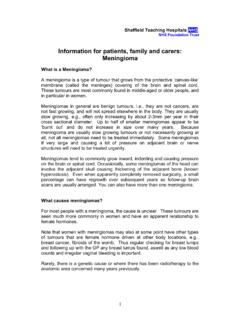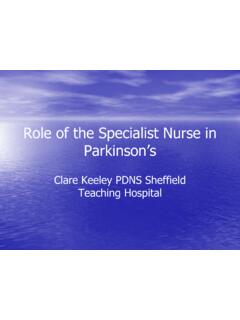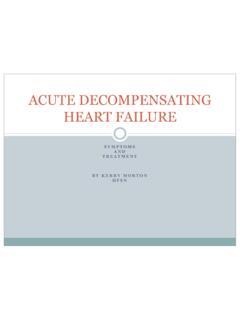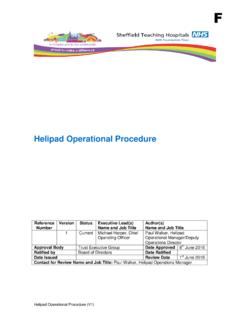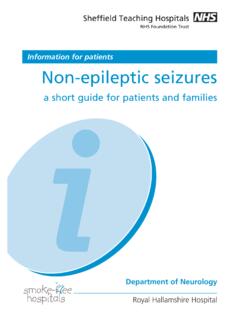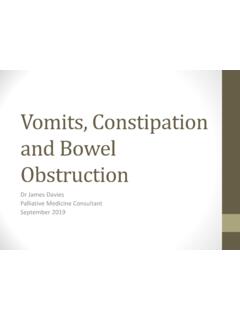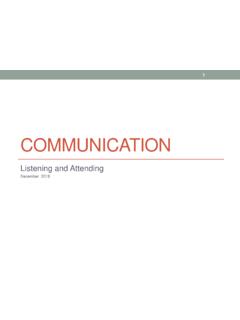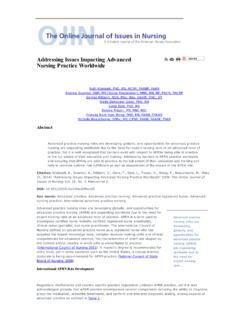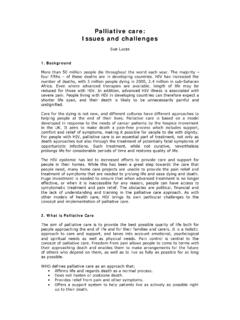Transcription of Ethical Issues in Palliative Care
1 Ethical Issues in Palliative care Facilitated by Lynne Ghasemi Senior Sister Principles of symptom management Why manage pain and symptoms? Benefits to patients and carers? Benefits to health care professionals? Are they always the same? Can we manage pain and symptoms as we would wish? What are the barriers and challenges from an Ethical perspective? Bio psycho social care _ Holistic care Pain and symptom management Patient adjustment to illness/dying Affects on the family Partnership with the patient Ethical Issues Palliative care Seeks to manage the symptoms of advanced and terminal illness Views people as a whole individual rather than a disease process to be treated Body/Physical Mind/psychological Heart/social Soul/spiritual Delivers holistic care through multidisciplinary team working What do we mean by ethics?
2 Principle based approach favoured in modern healthcare setting and in western culture(Gillon, 1994). Culturally neutral with common moral language. Could be open to interpretation (Seedhouse, 1998). Trivialise real dilemmas faced in healthcare. Respect for autonomy to respect the autonomy of individual. Beneficence to do good. Non-malificence to do no intentional harm. Justice Respect for autonomy has limitations. Must be compatible with the autonomy of all those affected Obligation in the clinical setting to provide information to allow patients to make informed autonomous decisions Major challenge in patients incapacitated by serious illness.
3 Symptom management may compromise autonomy whilst being of benefit. Duty to act in the patients best interests Very pertinent in end of life care Can withdrawal/withholding of treatment be in a patients best interests? Balance of burdens v benefits. Very important to assess risk of side effects in symptom management Can death be in someone's best interests? A duty not to cause intentional harm. Fundamental tenet of practice Medical treatments have side effects but ultimately save/improve lives. In end of life decisions the question of how much harm is caused by the treatment needs to be considered, as does the question of whether death itself is always a harm.
4 Justice Resources! Cost of medication Availability of care /intervention Clinical trials Evidence based symptom management Difficulties related to evidence in Palliative care The professionals obligation to promote a patients best interests. Two forms of best interest (Ellis 1996) Experiential a persons personal tastes and desires Critical relates to matters of judgement, the intrinsic value of human worth. Applied to decision making by persons other than the patient determines the highest benefit amongst available options after considering costs and benefits Any treatment which has the potential to postpone death. Includes CPR, ventilation, renal dialysis, specialised treatments such as chemotherapy, antibiotics for severe infection and artificial nutrition and hydration.
5 BUT use of antibiotics, nutrition and hydration may be justified if they symptomatically improve the patient. Focus of care High-quality treatment and care towards the end of life includes: Palliative care that focuses on managing pain and other distressing symptoms providing psychological, social and spiritual support to patients supporting those close to the patient. How decisions are made Decision making in care towards the end of life is essentially the same as for any other phase of clinical care . We use the term overall benefit to describe the Ethical basis on which decisions are made about treatment and care for adult patients who lack capacity to decide.
6 Nutrition and hydration provided by tube or drip are regarded in law as medical treatment. Some people see nutrition and hydration, whether taken orally or by tube or drip, as part of basic nurture for the patient that should almost always be provided Nutrition and hydration You must keep the nutrition and hydration status of your patients under review. You should be satisfied that nutrition and hydration are being provided in a way that meets your patients needs If necessary patients are being given adequate help to enable them to eat and drink. Clinically assisted nutrition and hydration Intravenous feeding (TPN), nasogastric tube and by percutaneous endoscopic gastrostomy (PEG) and radiologically inserted gastrostomy (RIG) feeding tubes through the abdominal wall.
7 All these means of providing nutrition also provide fluids necessary to keep patients hydrated. Clinically assisted hydration can also be provided by intravenous or subcutaneous infusion of fluids through a drip . Balanced choices Providing nutrition and hydration by tube or drip may provide symptom relief, or prolong or improve the quality of the patient s life; but they may also present problems The current evidence about the benefits, burdens and risks of these techniques as patients approach the end of life is not clear-cut. What do you already know? Benefits of artificial hydration Burdens and risks of artificial hydration What do patients, families and health care workers worry about?
8 That patients who are unconscious or semi-conscious may be experiencing distressing symptoms and complications Or otherwise be suffering either because their needs for nutrition or hydration are not being met because attempts to meet their perceived needs for nutrition or hydration may be causing them avoidable suffering. Making plans For this reason it is especially important that you listen to and consider the views of the patient and of those close to them (including their cultural and religious views) Explain the Issues to be considered, including the benefits, burdens and risks of providing clinically assisted nutrition and hydration Informed decisions You should make sure that patients, those close to them and the healthcare team understand that, when clinically assisted nutrition or hydration would be of overall benefit, it will always be offered If a decision is taken not to provide clinically assisted nutrition or hydration, the patient will continue to receive high-quality care , with any symptoms addressed.
9 Patient informed request If a patient has previously requested that nutrition or hydration be provided until their death, or those close to the patient are sure that this is what the patient wanted, the patient s wishes must be given weight and, when the benefits, burdens and risks are finely balanced, will usually be the deciding factor. Case Review Mrs D a 57 year old Huntingdon s Disease sufferer Has had SALT assessment currently deemed able to swallow soft mashable diet and thickened fluids if sat upright and assisted and maintained upright for 30 minutes after eating Had previously apparently expressed when she had capacity that she would not want to be PEG fed.
10 She has uncontrolled movements due to disease Husband who has POA is keen that PEG feeding is not ruled out if she becomes unable to swallow with risk of aspiration Case Review Best interests meeting Discussed even with a PEG there can be a risk of aspiration due to risk of regurgitation Also risk of the PEG being pulled out due to unpredictable movements Insertion is an invasive procedure which in her case would require GA due to unpredictable movements and inability to understand what is happening Discussed that an emergency decision to insert a PEG may not be in best interests particularly if she did not respond to IV antibiotics to treat aspiration pneumonia as comfort measures for end of life care only would be appropriate Outcome If it was deemed that PEG insertion was appropriate she would not be suitable for continuous pump feeding due to risk of dislodging the tube/feed but would require bolus feeding PEG insertion is a medical procedure/treatment and ultimately a medical decision Outcome Husband also expressed he wished his wife to remain for CPR at present He would wish her to receive oral antibiotics if diagnosed with infection and escalation to hospital for IV antibiotics if needed He understood that if his wife was clearly approaching the end of her life that comfort
